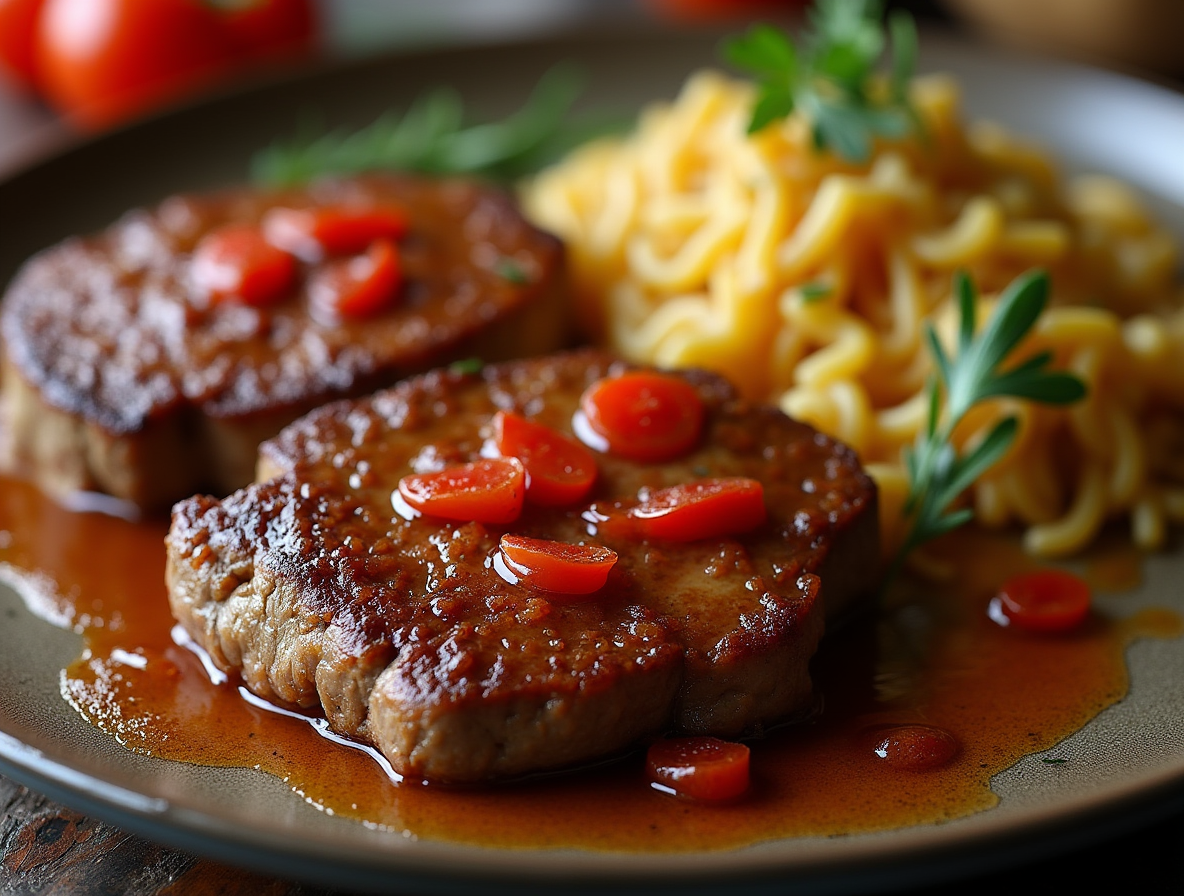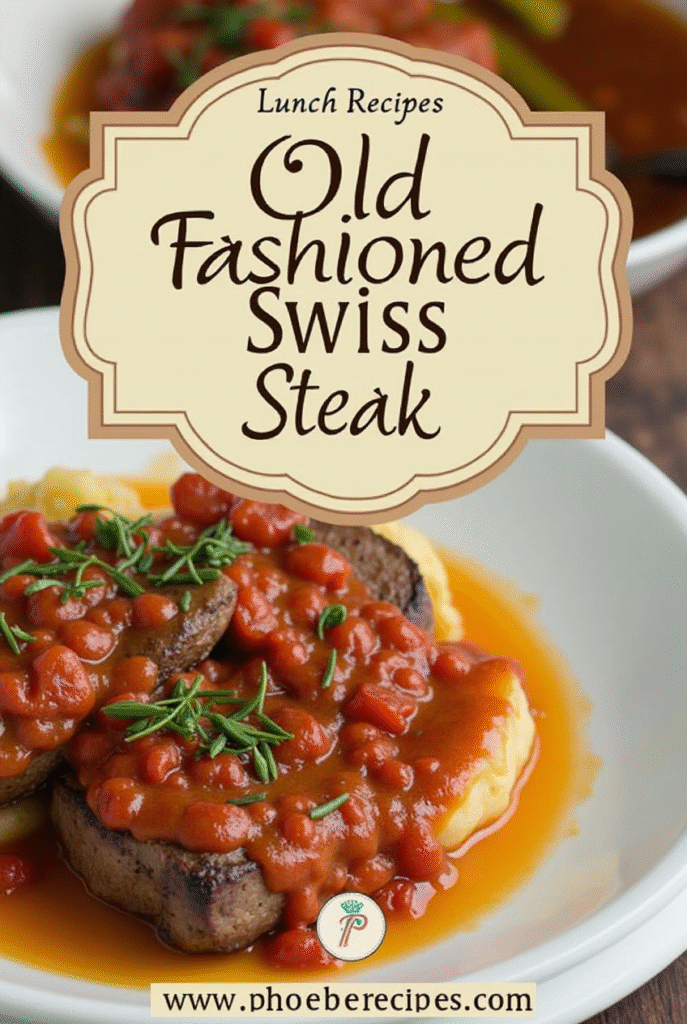Old-Fashioned Swiss Steak Recipe: The Secret to Perfect Tender Meat (Grandma’s Way)
Swiss steak surprisingly has nothing to do with Switzerland! The old fashioned swiss steak recipe gets its name from the technique of “swissing,” which refers to the meat tenderizing process rather than any European origin. This budget-friendly dish traditionally uses cubed steak—an economical cut that’s been mechanically tenderized—making it perfect for stretching your grocery budget while still serving a hearty, satisfying meal.
I’ve always loved how grandma’s swiss steak transforms tougher cuts of meat into fork-tender delights through patient slow cooking. The vintage swiss steak recipe typically includes round steak, stewed tomatoes, and a variety of vegetables that contribute to its rich flavor profile. Before the long simmer begins, the meat is dredged in flour and thoroughly browned, which enhances both texture and taste. With approximately 508 calories and 45g of protein per serving, the best old fashioned swiss steak recipe is certainly a filling option that’s often served over mashed potatoes, rice, or noodles, highlighting its versatility as a comfort food.
Choosing the Right Cut of Meat for Swiss Steak
Traditionally, tough cuts of beef have been the foundation of any old fashioned swiss steak recipe. These economical options transform into something extraordinary through proper preparation and cooking techniques.
Why round steak is traditional
Round steak has long been the gold standard for vintage swiss steak recipes due to its perfect balance of flavor and affordability. This cut comes from the rear leg of the cow, making it lean yet full of rich beef flavor. Top round and bottom round steaks are particularly popular choices because they become wonderfully fork-tender after a long, slow braise in a tomato-based sauce. Chuck steak serves as another excellent option, offering slightly more marbling that contributes additional flavor during the cooking process.
I’ve found that when preparing grandma’s swiss steak, the thickness of your meat matters significantly. Look for steaks cut about 3/4-inch thick – this provides enough substance to withstand tenderizing without falling apart. Some enthusiasts prefer beef chuck eye for its ideal marbling, ensuring the meat stays juicy throughout cooking.
What is ‘swissing’ and why it matters
The term “swiss” in old fashioned swiss steak recipe has nothing to do with geography. Instead, it refers to a specific tenderizing technique called “swissing”. This process involves pounding or rolling meat to break down tough connective tissues. Although most home cooks use a textured mallet, professional kitchens might employ a specialized tool called a “swisser” – a machine with dozens of tiny blades that create hundreds of small cuts in the meat.
Swissing fundamentally changes the texture of tough cuts. When I prepare vintage swiss steak recipes, I thoroughly pound both sides of the meat until it’s approximately 1/2-inch thick. This mechanical tenderizing process creates distinctive cube-shaped indentations while physically breaking down muscle fibers, allowing the meat to absorb more moisture and become tender during cooking.
Cube steak vs. round steak: which is better?
Cube steak essentially represents round steak that has already undergone the swissing process. The name comes from the cube-shaped marks left by the mechanical tenderizer. For time-strapped cooks, pre-tenderized cube steak offers convenience without sacrificing quality in your old fashioned swiss steak recipe.
However, starting with untenderized round steak gives you greater control over the tenderizing process. Additionally, some cooks claim that manually tenderized meat absorbs seasonings more effectively than pre-processed cube steak.
If cube steak isn’t available, you can purchase top or bottom round and tenderize it at home using a meat mallet. Alternatively, many butchers will gladly run your chosen cut through their tenderizer upon request.
Grandma’s Preparation Secrets for Tender Meat
The magic of grandma’s swiss steak lies in the meticulous preparation steps that transform tough cuts into tender morsels. These time-honored techniques are what make the old fashioned swiss steak recipe truly special.
How to properly flour and season the steak
For authentic vintage swiss steak recipes, the seasoning process starts with a simple yet effective dry mixture. First, I combine all-purpose flour with salt, black pepper, and paprika on a plate. Some traditional recipes call for garlic powder or onion powder as well. The ratio matters—approximately 1/2 cup of flour mixed with 1-2 teaspoons each of salt and pepper creates the perfect coating.
The technique is equally important as the ingredients. I always pat the meat completely dry with paper towels beforehand—moisture prevents proper flour adhesion. Then, press the flour mixture firmly into both sides of the meat. This isn’t just a light dusting; the flour needs to become one with the meat, filling those tenderized indentations completely.
The importance of pounding the meat
Properly tenderizing the meat remains fundamental to any best old fashioned swiss steak recipe. Using a meat mallet with the textured side, I pound both sides of the steak thoroughly until it’s approximately 1/2-inch thick. This mechanical process physically breaks down tough muscle fibers and connective tissues.
Furthermore, pounding creates small pockets in the meat that capture both seasonings and gravy during cooking. For grandma’s swiss steak, this step cannot be rushed—spend at least 2-3 minutes per side, working methodically across the entire surface.
Why browning the meat first makes a difference
Following flour coating, browning the meat properly creates the foundation for exceptional flavor. This step triggers the Maillard reaction—a chemical process that develops deep, complex flavors impossible to achieve otherwise.
For traditional old fashioned swiss steak recipe in oven, I always brown each piece in hot oil until deep golden on both sides. This step takes patience—approximately 3-4 minutes per side—but creates a flavorful crust that enhances the final dish dramatically while sealing in juices.
Slow Cooking the Old-Fashioned Way
The slow cooking process is where patience truly yields perfection in any old fashioned swiss steak recipe. Once you’ve selected and prepared your meat, the cooking method you choose will determine both the flavor profile and your level of involvement in the process.
Oven-baked vs. stovetop vs. slow cooker
For traditional old fashioned swiss steak recipe in oven, preheat to 300-350°F and use a Dutch oven with a tight-fitting lid. This method creates an evenly distributed heat that gently breaks down tough fibers. Stovetop cooking requires more attention—maintain the lowest possible simmer and use a domed lid to circulate moisture effectively. Many cooks swear by this method for its ability to develop deeper flavors through constant, gentle heat.
For a modern twist on grandma’s swiss steak, slow cookers offer convenience without sacrificing quality. After browning the meat, simply transfer everything to your crockpot and cook on low for 6-8 hours or high for 4-5 hours. The results are remarkably similar to traditional methods, making this ideal for busy households.
Building the tomato-based gravy
The signature gravy begins with browned bits from the pan—never discard these flavor bombs! Deglaze with beef broth or a splash of wine, then add tomatoes. Options include:
- Stewed tomatoes for chunky texture
- Tomato sauce for smoothness
- Whole peeled tomatoes, hand-crushed for rustic appeal
Worcestershire sauce adds depth, while some vintage swiss steak recipes include a touch of brown sugar to balance acidity. For thickening, rely on the flour from dredging or add a cornstarch slurry near the end of cooking.
Vegetables that enhance the flavor
Onions form the flavor foundation of any best old fashioned swiss steak recipe. Slow-caramelized onions develop remarkable sweetness and complexity. Celery and carrots contribute aromatic notes and natural sweetness, whereas green peppers add distinctive brightness. For maximum flavor, lightly brown vegetables before adding liquid ingredients.
How long to cook for perfect tenderness
Timing varies by method: oven-baked requires approximately 2 to 2½ hours, stovetop needs 1½ to 2 hours, and slow cookers need 6-8 hours on low. Regardless of method, the meat should be fork-tender—meaning it yields easily when pierced. Flipping the steaks occasionally ensures even cooking and flavor absorption. Resist the urge to rush this process; the transformation from tough to tender simply cannot be accelerated.
Serving and Storing Your Vintage Swiss Steak
After perfecting your old fashioned swiss steak recipe, serving it with complementary sides and knowing how to properly store leftovers ensures you get maximum enjoyment from this classic dish.
Best sides to serve with Swiss steak
The rich tomato gravy in vintage swiss steak recipes practically begs for starchy sides that can soak up all that delicious sauce. Mashed potatoes remain the traditional favorite, creating the perfect base for your flavorful meat and gravy. Rice pilaf or buttered noodles offer excellent alternatives that pair wonderfully with the tangy tomato sauce.
For vegetables, consider these classic accompaniments:
- Green beans or asparagus (sautéed or steamed)
- Broccoli or collard greens
- Colorful carrots (try brown sugar glazed for sweetness)
- Cucumber or coleslaw for refreshing crunch
Moreover, don’t forget bread options! Cornbread, biscuits, or crusty farmhouse bread provide perfect vehicles for sopping up every last drop of that magnificent gravy.
How to store and reheat leftovers
First thing to remember when storing grandma’s swiss steak is to let it cool completely before refrigerating. Subsequently, transfer everything to an airtight container, making sure to include plenty of gravy to keep the meat moist. Properly stored, your old fashioned swiss steak will maintain quality for 3-4 days in the refrigerator.
For reheating, the stovetop method yields the best results. Place the desired portions in a covered pan over low heat for 10-12 minutes, occasionally stirring until warmed through. In fact, many cooks insist swiss steak tastes even better the next day after flavors have had time to meld together!
Can you freeze Swiss steak?
Absolutely! Old fashioned swiss steak recipe freezes remarkably well. To do this properly, cool completely, then transfer to freezer-safe containers or vacuum-sealed bags. Your frozen swiss steak will maintain quality for 2-3 months when properly stored.
To thaw, place in the refrigerator overnight—never at room temperature. Gently reheat using the stovetop method mentioned above, adding a splash of beef broth if the gravy needs thinning.
Conclusion
Swiss steak stands as a testament to culinary ingenuity, transforming budget-friendly cuts into mouthwatering meals through time-honored techniques. Throughout this article, we’ve explored everything from selecting the right cut to mastering the distinctive “swissing” process that gives this dish its name.
Patience certainly plays a crucial role when preparing this classic comfort food. The slow cooking process breaks down tough fibers, while the rich tomato gravy infuses the meat with remarkable flavor. Whether you choose the oven, stovetop, or slow cooker method, the end result remains consistently satisfying.
Many families cherish recipes passed down through generations, and old-fashioned Swiss steak undoubtedly deserves its place in this treasured collection. My grandmother’s version always brought everyone to the table with eager anticipation, proving that simple ingredients can create extraordinary meals.
Additionally, the versatility of Swiss steak makes it perfect for any season. Serve it with mashed potatoes during winter months or alongside a crisp cucumber salad when warmer weather arrives. Leftovers taste even better the next day, though they rarely last that long in most households!
Fundamentally, Swiss steak reminds us that good cooking often means giving humble ingredients time and attention. This approach not only stretches your food budget but also connects us to culinary traditions worth preserving. Next time you spot an economical cut of beef at the market, remember this classic technique – your family will thank you for the delicious results that follow.
FAQs
Q1. What cut of meat is best for Swiss steak? Round steak is traditionally used for Swiss steak, though chuck steak can also work well. These tougher, more economical cuts become tender through the cooking process.
Q2. How do you tenderize the meat for Swiss steak? The meat is typically tenderized by pounding it with a meat mallet or the edge of a plate. This process, called “swissing,” breaks down tough muscle fibers and helps the meat absorb flavors.
Q3. What’s the secret to making Swiss steak tender? The key is slow cooking. Whether using an oven, stovetop, or slow cooker, Swiss steak should be cooked at a low temperature for 2-3 hours until fork-tender.
Q4. What ingredients are essential for Swiss steak? Basic ingredients include beef, flour, oil, onions, and tomato sauce or stewed tomatoes. Many recipes also include vegetables like carrots, celery, and bell peppers.
Q5. How is Swiss steak typically served? Swiss steak is often served over mashed potatoes, rice, or egg noodles to soak up the flavorful gravy. It’s commonly paired with vegetables like green beans or corn for a complete meal.


